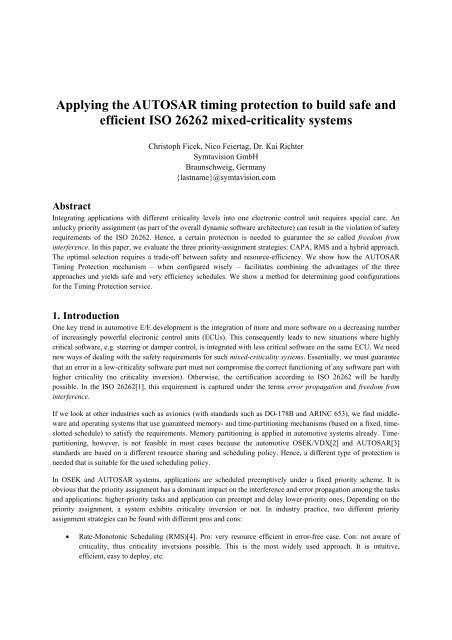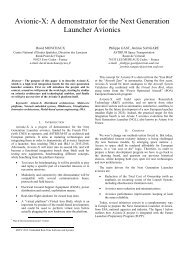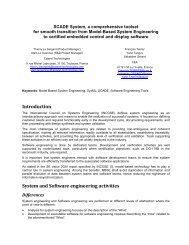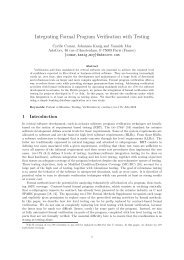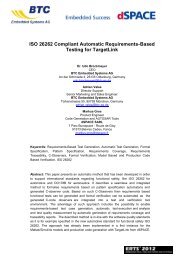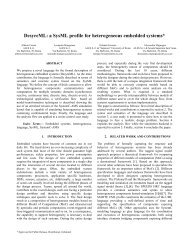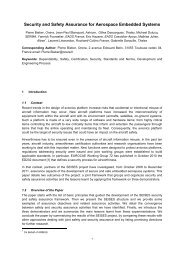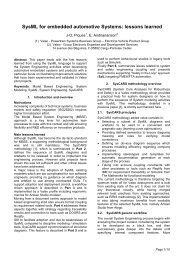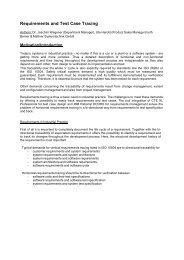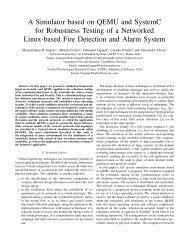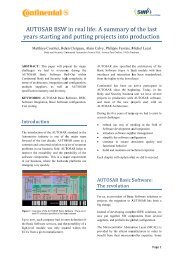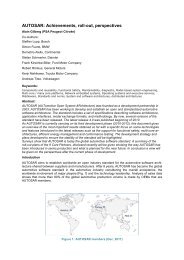Applying the AUTOSAR timing protection to build safe and efficient ...
Applying the AUTOSAR timing protection to build safe and efficient ...
Applying the AUTOSAR timing protection to build safe and efficient ...
You also want an ePaper? Increase the reach of your titles
YUMPU automatically turns print PDFs into web optimized ePapers that Google loves.
<strong>Applying</strong> <strong>the</strong> <strong>AUTOSAR</strong> <strong>timing</strong> <strong>protection</strong> <strong>to</strong> <strong>build</strong> <strong>safe</strong> <strong>and</strong><br />
<strong>efficient</strong> ISO 26262 mixed-criticality systems<br />
Chris<strong>to</strong>ph Ficek, Nico Feiertag, Dr. Kai Richter<br />
Symtavision GmbH<br />
Braunschweig, Germany<br />
{lastname}@symtavision.com<br />
Abstract<br />
Integrating applications with different criticality levels in<strong>to</strong> one electronic control unit requires special care. An<br />
unlucky priority assignment (as part of <strong>the</strong> overall dynamic software architecture) can result in <strong>the</strong> violation of <strong>safe</strong>ty<br />
requirements of <strong>the</strong> ISO 26262. Hence, a certain <strong>protection</strong> is needed <strong>to</strong> guarantee <strong>the</strong> so called freedom from<br />
interference. In this paper, we evaluate <strong>the</strong> three priority-assignment strategies: CAPA, RMS <strong>and</strong> a hybrid approach.<br />
The optimal selection requires a trade-off between <strong>safe</strong>ty <strong>and</strong> resource-efficiency. We show how <strong>the</strong> <strong>AUTOSAR</strong><br />
Timing Protection mechanism – when configured wisely – facilitates combining <strong>the</strong> advantages of <strong>the</strong> three<br />
approaches <strong>and</strong> yields <strong>safe</strong> <strong>and</strong> very efficiency schedules. We show a method for determining good configurations<br />
for <strong>the</strong> Timing Protection service.<br />
1. Introduction<br />
One key trend in au<strong>to</strong>motive E/E development is <strong>the</strong> integration of more <strong>and</strong> more software on a decreasing number<br />
of increasingly powerful electronic control units (ECUs). This consequently leads <strong>to</strong> new situations where highly<br />
critical software, e.g. steering or damper control, is integrated with less critical software on <strong>the</strong> same ECU. We need<br />
new ways of dealing with <strong>the</strong> <strong>safe</strong>ty requirements for such mixed-criticality systems. Essentially, we must guarantee<br />
that an error in a low-criticality software part must not compromise <strong>the</strong> correct functioning of any software part with<br />
higher criticality (no criticality inversion). O<strong>the</strong>rwise, <strong>the</strong> certification according <strong>to</strong> ISO 26262 will be hardly<br />
possible. In <strong>the</strong> ISO 26262[1], this requirement is captured under <strong>the</strong> terms error propagation <strong>and</strong> freedom from<br />
interference.<br />
If we look at o<strong>the</strong>r industries such as avionics (with st<strong>and</strong>ards such as DO-178B <strong>and</strong> ARINC 653), we find middleware<br />
<strong>and</strong> operating systems that use guaranteed memory- <strong>and</strong> time-partitioning mechanisms (based on a fixed, timeslotted<br />
schedule) <strong>to</strong> satisfy <strong>the</strong> requirements. Memory partitioning is applied in au<strong>to</strong>motive systems already. Timepartitioning,<br />
however, is not feasible in most cases because <strong>the</strong> au<strong>to</strong>motive OSEK/VDX[2] <strong>and</strong> <strong>AUTOSAR</strong>[3]<br />
st<strong>and</strong>ards are based on a different resource sharing <strong>and</strong> scheduling policy. Hence, a different type of <strong>protection</strong> is<br />
needed that is suitable for <strong>the</strong> used scheduling policy.<br />
In OSEK <strong>and</strong> <strong>AUTOSAR</strong> systems, applications are scheduled preemptively under a fixed priority scheme. It is<br />
obvious that <strong>the</strong> priority assignment has a dominant impact on <strong>the</strong> interference <strong>and</strong> error propagation among <strong>the</strong> tasks<br />
<strong>and</strong> applications: higher-priority tasks <strong>and</strong> application can preempt <strong>and</strong> delay lower-priority ones. Depending on <strong>the</strong><br />
priority assignment, a system exhibits criticality inversion or not. In industry practice, two different priority<br />
assignment strategies can be found with different pros <strong>and</strong> cons:<br />
<br />
Rate-Mono<strong>to</strong>nic Scheduling (RMS)[4]. Pro: very resource <strong>efficient</strong> in error-free case. Con: not aware of<br />
criticality, thus criticality inversions possible. This is <strong>the</strong> most widely used approach. It is intuitive,<br />
<strong>efficient</strong>, easy <strong>to</strong> deploy, etc.
Criticality-As-Priority-Assignment (CAPA)[5]. Pro: no criticality inversion in schedule. Con: less resource<br />
<strong>efficient</strong> (in all cases). This is quite new <strong>and</strong> used only in high-criticality systems, so far.<br />
We explain both approaches later in detail. For this introduction, we conclude that <strong>the</strong> established strategies let us<br />
<strong>build</strong> systems that are ei<strong>the</strong>r resource-<strong>efficient</strong> or <strong>safe</strong>, but not both.<br />
We have shown in[6] that <strong>the</strong>re exist a third, hybrid priority assignment approach that balances <strong>the</strong> pros <strong>and</strong> cons of<br />
pure CAPA <strong>and</strong> pure RMS. The approach uses a) CAPA for <strong>the</strong> highest criticality levels, <strong>and</strong> b) RMS for those<br />
criticality levels that are ei<strong>the</strong>r b1) low-criticality or b2) are protected by using <strong>the</strong> Timing Protection mechanism of<br />
<strong>AUTOSAR</strong>. The contribution in [6] introduces <strong>the</strong> overall methodology <strong>to</strong> select <strong>the</strong> right strategy. It was shown that<br />
<strong>the</strong> use of Timing Protection can enlarge <strong>the</strong> design space, i.e. <strong>the</strong> flexibility in setting up <strong>the</strong> dynamic software<br />
architecture.<br />
In this paper, we explain in detail, how <strong>the</strong> Timing Protection service works, how it facilitates <strong>safe</strong> <strong>and</strong> <strong>efficient</strong><br />
schedules, <strong>and</strong> how <strong>the</strong> service itself must be configured. Especially we show how good (reasonable) Timing<br />
Protection Budget values (TPB) can be determined <strong>and</strong> how <strong>the</strong>y interacts with Recovery Times (RCT). We will see<br />
that this is only possible through an assessment of <strong>the</strong> expected execution times of tasks, <strong>and</strong> a reliable scheduling<br />
analysis in <strong>the</strong> error-free <strong>and</strong> <strong>the</strong> error-case.<br />
The paper is organized as follows: In <strong>the</strong> next Section, we review <strong>the</strong> relevant requirements from <strong>the</strong> ISO 26262 on<br />
<strong>the</strong> software architecture, in particular <strong>the</strong> task schedule. Then, we illustrate <strong>the</strong> three strategies mentioned (RMS,<br />
CAPA, hybrid) using a comprehensive example. In Section 4 we introduce <strong>the</strong> details of Timing Protection <strong>and</strong><br />
explain <strong>the</strong> parameters <strong>and</strong> how TPB values can be determined. This will include a certain amount of analyses that<br />
must be performed. Finally, we draw our conclusions.<br />
2. Safety requirements<br />
2.1. ISO 26262<br />
In 1998, <strong>the</strong> International Electrotechnical Commission (IEC) issued <strong>the</strong> first edition of IEC 61508. This st<strong>and</strong>ard<br />
regulates <strong>the</strong> development of electrical, electronic <strong>and</strong> programmable electronic (E/E/PE) systems with <strong>safe</strong>ty<br />
functions.<br />
With <strong>the</strong> increasing complexity of electronic components in <strong>the</strong> vehicle, it was necessary <strong>to</strong> capture <strong>the</strong> specific<br />
properties in <strong>the</strong> development of <strong>the</strong>se components in an own st<strong>and</strong>ard. ISO 26262 ("road vehicles - functional<br />
<strong>safe</strong>ty"). This st<strong>and</strong>ard regulates <strong>the</strong> implementation of <strong>the</strong> functional <strong>safe</strong>ty of a system with electrical/electronic<br />
components in a vehicle.<br />
For <strong>the</strong> development of components it is necessary <strong>to</strong> know <strong>the</strong> assigned au<strong>to</strong>motive <strong>safe</strong>ty integrity level ASIL,<br />
because <strong>the</strong> measures <strong>and</strong> methods in <strong>the</strong> development process, as well as <strong>the</strong> necessary technical mechanisms<br />
depend on this classification. The ASIL classification is <strong>the</strong> result of <strong>the</strong> risk analysis <strong>and</strong> risk assessment. Four<br />
levels of security exist A, B, C, D, <strong>and</strong> <strong>the</strong> classification "not critical". The security requirements of <strong>the</strong> system <strong>and</strong><br />
thus <strong>the</strong> requirements for <strong>the</strong> methods, measures <strong>and</strong> mechanisms increase with increasing ASIL.<br />
2.2. Freedom From Interference<br />
ISO 26262 contains 10 parts. Part 6 - Product development at <strong>the</strong> software level - describes <strong>the</strong> necessary measures<br />
<strong>and</strong> methods for <strong>the</strong> software part of a systems. Chapter 7 <strong>and</strong> annex D define <strong>the</strong> requirements <strong>to</strong> fulfill if a software<br />
system is <strong>build</strong>up of components with different criticality levels.<br />
The ISO dem<strong>and</strong>ed <strong>to</strong> use <strong>the</strong> highest ASIL in <strong>the</strong> system for all components if interference between <strong>the</strong> components<br />
cannot be excluded. Interference includes memory, execution time <strong>and</strong> communication.
The development according <strong>to</strong> this approach, using <strong>the</strong> highest ASIL, is not practical. To realize such mixed<br />
criticality systems, which are certifiable, measures, methods <strong>and</strong> technical mechanism are required <strong>to</strong> guarantee <strong>the</strong><br />
freedom from interference between <strong>the</strong> components. Certification can also be achieved if interference is allowed on<br />
purpose, but it is shown or guaranteed that all interference are recognized <strong>and</strong> processed in a way that <strong>safe</strong>ty goals<br />
are not violated. In this paper we are concentrating on <strong>the</strong> scheduling <strong>and</strong> <strong>the</strong> interference in execution time.<br />
3. Contradicting design patterns<br />
In this section we illustrate <strong>the</strong> two established priority-assignment strategies, <strong>and</strong> <strong>the</strong>ir pros <strong>and</strong> cons for mixedcriticality<br />
systems. This is demonstrated in <strong>the</strong> following example:<br />
Application /<br />
Task<br />
ASIL level<br />
Cycle time / max. runtime<br />
(Deadline)[ms]<br />
Runtime [ms] RMS priority CAPA<br />
priority<br />
T1 ASIL-C 5 0,5 4 10<br />
T2 ASIL-B 10 1,2 8 8<br />
T3 ASIL-A 1 0,2 10 6<br />
T4 QM 10 3 6 4<br />
Table 1 ASIL levels, priorities <strong>and</strong> ASIL levels of <strong>the</strong> example system<br />
Table 1 includes <strong>the</strong> resource <strong>and</strong> <strong>safe</strong>ty requirements of four applications (tasks), <strong>and</strong> <strong>the</strong>ir maximum runtime<br />
requirements (deadlines) which correspond <strong>to</strong> <strong>the</strong> period in this example. One of <strong>the</strong> most important properties that<br />
needs <strong>to</strong> be determined during <strong>the</strong> integration is <strong>the</strong> task priority. According <strong>to</strong> <strong>the</strong> Rate-Mono<strong>to</strong>nic Scheduling<br />
method (RMS) [4], <strong>the</strong> priority is derived from <strong>the</strong> cycle time: <strong>the</strong> shorter <strong>the</strong> cycle time, <strong>the</strong> higher <strong>the</strong> priority.<br />
According <strong>to</strong> <strong>the</strong> Criticality Aware Priority Assignment method (CAPA) [5], <strong>the</strong> task with <strong>the</strong> highest <strong>safe</strong>ty level is<br />
given <strong>the</strong> highest priority. Table 1 shows <strong>the</strong> resulting priorities for both methods.<br />
Nei<strong>the</strong>r of <strong>the</strong> two methods yields <strong>to</strong> a satisfying result. The priorities from <strong>the</strong> RMS method result in a task schedule<br />
that meets all deadlines. However, <strong>the</strong> schedule does not guarantee <strong>the</strong> necessary freedom from interference. The<br />
ASIL-C application can be interrupted by all o<strong>the</strong>r applications, this is called criticality inversion[5]. For instance, a<br />
runtime error in <strong>the</strong> ASIL-A function could possibly block <strong>the</strong> ASIL-C-function permanently. illustrates <strong>the</strong><br />
schedule <strong>and</strong> <strong>the</strong> interferences in a Gantt diagram. The RMS approach <strong>the</strong>refore does not provide sufficient <strong>safe</strong>ty.<br />
Such criticality inversions are naturally avoided when using <strong>the</strong> CAPA approach; only higher ASIL levels can<br />
preempt <strong>and</strong> block lower ASIL levels, not <strong>the</strong> o<strong>the</strong>r way round. According <strong>to</strong> ISO 26262, this is not considered<br />
critical. However, <strong>the</strong> resources – particularly CPU time – are not being used <strong>efficient</strong>ly. Figure 2 illustrates <strong>the</strong><br />
schedule: due <strong>to</strong> <strong>the</strong> modified priorities, <strong>the</strong> deadline of task T3 is being violated.<br />
The example shows <strong>the</strong> mutual impact of design patterns <strong>and</strong> <strong>safe</strong>ty requirements on <strong>the</strong> fulfillment of real-time<br />
properties. The existing patterns (RMS <strong>and</strong> CAPA) do not make it possible <strong>to</strong> fulfill both requirements at <strong>the</strong> same<br />
time. Therefore, new design paradigms are needed, or <strong>the</strong> existing ones have <strong>to</strong> be adjusted <strong>to</strong> <strong>the</strong> new requirements.
Figure 1 Software schedule according <strong>to</strong> RMS (Rate-Mono<strong>to</strong>nic-Scheduling)<br />
Figure 2 Software schedule according <strong>to</strong> CAPA (Criticality-as-priority assignment)<br />
4. <strong>AUTOSAR</strong> Timing Protection<br />
Timing Protection is an <strong>AUTOSAR</strong> system service that moni<strong>to</strong>rs different parameters during <strong>the</strong> run time of <strong>the</strong><br />
system. These are:<br />
<br />
<br />
<br />
The execution time of tasks or functions<br />
The inter-arrival time of events<br />
The locking time for shared resources or interrupts
All are important <strong>and</strong> useful, but for this paper we are concentrating on <strong>the</strong> execution time moni<strong>to</strong>ring. For this a<br />
budget for <strong>the</strong> execution time of a task is defined. In <strong>the</strong> event that any task exceeds <strong>the</strong> preset execution budgets,<br />
this is being interpreted as an error <strong>and</strong> a configurable error h<strong>and</strong>ling is executed. The Timing Protection does not<br />
fully eliminate criticality inversions, but <strong>the</strong> amount of possible interference is reliably bounded. The <strong>safe</strong>ty<br />
requirements of ISO 26262, especially <strong>the</strong> absence of error propagation, are <strong>the</strong>refore fulfilled.<br />
If Timing Protection is available in a system, <strong>the</strong> design space for <strong>the</strong> schedule is naturally enlarged, i.e. we have<br />
more design options because some of <strong>the</strong> criticality inversions can be secured explicitly. Limitations are introduced<br />
through <strong>the</strong> necessity <strong>to</strong> certify Timing Protection. In general, <strong>the</strong> Timing Protection should be developed according<br />
<strong>to</strong> <strong>the</strong> highest ASIL level of all applications (or higher). For <strong>the</strong> proper configuration of <strong>the</strong> Timing Protection<br />
(especially <strong>the</strong> runtime budgets), a reliable analysis <strong>and</strong> forecast of <strong>the</strong> critical schedule situations is m<strong>and</strong>a<strong>to</strong>ry.<br />
Figure 3 shows that all <strong>safe</strong>ty <strong>and</strong> real-time requirements can be met with a combination of RMS priority assignment,<br />
CAPA <strong>and</strong> Timing Protection. There are no disallowed interferences anymore, <strong>and</strong> all tasks reliably complete within<br />
<strong>the</strong>ir cycle times (deadlines).<br />
Figure 3 Mixed CAPA <strong>and</strong> RMS schedule with Timing Protection<br />
4.1. Timing Protection configuration<br />
In <strong>the</strong> previous section, we have shown that <strong>the</strong> Timing Protection Service can yield very <strong>efficient</strong> <strong>and</strong> <strong>safe</strong><br />
schedules, if properly configured. In this section, we present a method, <strong>to</strong> derive a proper configuration. This means,<br />
we show methods that let us determine <strong>the</strong> Timing Protection Budget (TPB) values, as <strong>the</strong> key configuration<br />
parameter of <strong>the</strong> Timing Protection service.<br />
What are <strong>the</strong> goals?<br />
<br />
<br />
<br />
<br />
All tasks/applications must be schedulable in <strong>the</strong> error-free case<br />
In <strong>the</strong> event of an error of a single task/application, <strong>the</strong> rest of <strong>the</strong> system must be schedulable<br />
The probability of false positives (error has been detected even if <strong>the</strong>re was no error) shall be as low as<br />
possible (soft quality goal)<br />
The resource efficiency shall be as large as possible (soft efficiency goal)<br />
These are reached by <strong>the</strong> following procedure:<br />
<br />
Determine <strong>the</strong> maximum execution times of all tasks
Perform a scheduling analysis for <strong>the</strong> error-free case, i.e. under <strong>the</strong> assumption that all tasks use <strong>the</strong>ir core<br />
execution times determined, but no <strong>timing</strong> <strong>protection</strong> steps in, etc. This must be schedulable.<br />
o Like shown in Figure 3 for our example.<br />
Select a TPB for each task; obviously this shall be larger than <strong>the</strong> maximum core execution time.<br />
o Section 4.2 shows how<br />
Perform scheduling analysis with TPB as maximum execution time<br />
o Because TPB are larger than core execution time, this will be less <strong>efficient</strong> (more “waste”). We<br />
will come <strong>to</strong> that later.<br />
o If this is schedulable, <strong>the</strong> system will work, even when <strong>the</strong> tasks exploit <strong>the</strong>ir full budget.<br />
Consider <strong>the</strong> error case<br />
o The cases <strong>to</strong> check depends on <strong>the</strong> chosen error strategy <strong>and</strong> will be explained in detail later<br />
If all is schedulable, or at least, no criticality inversion exists <strong>the</strong>n a possible configuration has been found.<br />
4.2. Timing budget determination<br />
Until now, we have not shown how <strong>the</strong> budget value itself can be determined. We look in<strong>to</strong> this now.<br />
The goal of <strong>the</strong> <strong>timing</strong> <strong>protection</strong> budget is <strong>to</strong> bind <strong>the</strong> execution time of a task. To do this it is necessary <strong>to</strong> know <strong>the</strong><br />
worst case execution time of tasks or <strong>the</strong> functions/runnables in <strong>the</strong> task. However, most likely <strong>the</strong> exact worst case<br />
execution time (WCET) is not known. Like in [7] we can assume that <strong>the</strong> execution time of high critical functions is<br />
determined with a bigger effort than for low critical ones. Developers have <strong>to</strong> spend more time <strong>and</strong> effort in<br />
validating <strong>and</strong> testing high criticality functions. The knowledge about <strong>the</strong> time critical paths is well known. With<br />
high probability <strong>the</strong> WCET will be not overrun during <strong>the</strong> runtime, except in real error cases.<br />
In practice several <strong>to</strong>ols <strong>and</strong> methods exist <strong>to</strong> get <strong>the</strong> WCET. For example static code analysis like it is available by<br />
AbsInt[8] can be used <strong>to</strong> get <strong>the</strong> WCET depending on <strong>the</strong> different HW platforms. A fur<strong>the</strong>r method is simulation for<br />
example with VaST <strong>to</strong>ols[9] or <strong>the</strong> tracing on <strong>the</strong> real target HW with e.g. Gliwa <strong>to</strong>ols[10].<br />
Low critical functions, like quality management, are less important <strong>and</strong> <strong>the</strong> effort for validating <strong>and</strong> testing is lower,<br />
mostly because of cost reasons. The determined WCET for such functions is not as <strong>safe</strong> as for high criticality ones.<br />
With higher probability <strong>the</strong> determined WCET will be overrun during <strong>the</strong> run time even in correct situations.<br />
So we can define different times, which are illustrated in Figure 4:<br />
<br />
<br />
<br />
<br />
<br />
<br />
CET : Core Execution Time<br />
o The time a function needs <strong>to</strong> run.<br />
o Depends on <strong>the</strong> executed code <strong>and</strong> changes during run time<br />
BCET Best Case Execution Time<br />
o Minimum possible CET<br />
WCET : Determined Worst Case Execution Time<br />
o Assumed WCET for a function<br />
WCET R : Real Worst Case Execution Time<br />
o The real but may be unknown maximum execution time for a task<br />
TPB: Timing Protection Budget value<br />
RCT : Recovery time<br />
o Time needed by recovery mechanisms in error cases
Figure 4 Task execution times<br />
The more we know about a function <strong>the</strong> closer <strong>the</strong> WCET gets <strong>to</strong> <strong>the</strong> WCET R <strong>and</strong> <strong>the</strong> insecurity is reduced.<br />
However, as we do not know how close we are, we are setting <strong>the</strong> TPB value a little bit higher than <strong>the</strong> WCET. This<br />
should avoid, that a task is killed not for error reasons, but because <strong>the</strong> WCET was not determined correctly. We call<br />
this extra amount of time Safe Charge SC. The <strong>safe</strong> charge is more or less a risk fac<strong>to</strong>r for not knowing <strong>the</strong> exact<br />
WCET R <strong>and</strong> <strong>the</strong> risk <strong>to</strong> configure <strong>the</strong> budget wrong.<br />
A practical suggestion could be this:<br />
ASIL-D: WCET + 5%<br />
ASIL-C: WCET + 10%<br />
ASIL-B: WCET + 15%<br />
ASIL-A: WCET + 20%<br />
ASIL-0: WCET + 25%<br />
We are granting for example for ASIL-A tasks 20% more run time than determined by a WCET assumption.<br />
However, this is only an example. In <strong>the</strong> end, <strong>the</strong> software developers, <strong>to</strong>ge<strong>the</strong>r with <strong>the</strong> integra<strong>to</strong>r, must make this<br />
decision, how much <strong>the</strong>y budget (TPB). The proposed TPBs may be <strong>safe</strong>, but of course <strong>the</strong> efficiency is decreasing<br />
because of over dimensioning <strong>the</strong> system. As a design decision (<strong>and</strong> with reasoning) <strong>the</strong> false positives for less<br />
critical functions can be accepted due <strong>to</strong> increase <strong>the</strong> performance <strong>and</strong> reduced <strong>the</strong> overestimation.<br />
A kind of tailoring between efficiency on <strong>the</strong> ECU, <strong>the</strong> effort for better WCET determination <strong>and</strong> <strong>the</strong> acceptance of<br />
error for non-critical functions takes place.<br />
4.3. Error case <strong>and</strong> recovery strategy<br />
In <strong>the</strong> case of an overrun of <strong>the</strong> execution time budget an error recovery is executed. What happens exactly is<br />
configurable. <strong>AUTOSAR</strong> describes in general three different scenarios:<br />
<br />
<br />
<br />
Task kill<br />
Application kill <strong>and</strong> restart (optional)<br />
ECU shutdown <strong>and</strong> restart (optional)<br />
The pure task kill means, that <strong>the</strong> task just ends. If it is a periodic task, it will be scheduled again according <strong>to</strong> his<br />
period when <strong>the</strong> triggering event arrives again. All code, which has not been executed until this point, will not be<br />
executed anymore. The functional consequences must be analyzed in detail, but are out of our focus. The kill itself<br />
needs some time, <strong>the</strong> recovery time RCT. To check <strong>the</strong> schedule for this situation, we are adding <strong>the</strong> RTC value <strong>to</strong><br />
<strong>the</strong> TPB <strong>and</strong> use this value in <strong>the</strong> scheduling analysis <strong>and</strong> investigate <strong>the</strong> consequences. Table 2 shows <strong>the</strong> different<br />
TPB <strong>and</strong> RCT values for <strong>the</strong> task schedule <strong>and</strong> Figure 5 shows <strong>the</strong> schedule for this configuration. The green boxes
mark <strong>the</strong> RCT. The concrete overhead for this time must be determined <strong>to</strong>ge<strong>the</strong>r with <strong>the</strong> Operating System vendor<br />
<strong>and</strong> also depends on <strong>the</strong> concrete hardware. We assumed, that all tasks will raise an error <strong>and</strong> need <strong>the</strong> RCT time. For<br />
this case <strong>the</strong> system is still schedulable in <strong>the</strong> example. Of course this is very pessimistic. In reality not all tasks will<br />
raise an error every execution. Detailed analysis can be made <strong>and</strong> assume that only one task will raise an error not so<br />
often <strong>and</strong> never simultaneously with o<strong>the</strong>r tasks, or only in few cases. In <strong>the</strong> end it depends on <strong>the</strong> detailed system<br />
<strong>and</strong> <strong>the</strong> reasoning, but it must be done during <strong>the</strong> certification process.<br />
Application /<br />
Task<br />
ASIL level Cycle time / max.<br />
runtime (Deadline)[ms]<br />
Runtime<br />
[ms]<br />
Time<br />
Protection<br />
Budget<br />
TPB<br />
Recovery<br />
Time RCT<br />
priority<br />
T1 ASIL-C 5 0,5 0,55 50µs 10<br />
T2 ASIL-B 10 1,2 1,38 50µs 6<br />
T3 ASIL-A 1 0,2 0,24 50µs 8<br />
T4 QM 10 3 3,75 50µs 4<br />
Table 2 Task configuration with TPB <strong>and</strong> RCT values<br />
Figure 5 Schedule with Recovery Time RCT<br />
The application kill means <strong>the</strong> end of <strong>the</strong> current task, which violates <strong>the</strong> budget, <strong>and</strong> all o<strong>the</strong>r tasks belonging <strong>to</strong> a<br />
certain application. If <strong>the</strong> application is s<strong>to</strong>pped, <strong>the</strong> schedulability can be checked like for <strong>the</strong> task kill described<br />
before. For a restart of <strong>the</strong> application a specific restart task has <strong>to</strong> be configured in <strong>AUTOSAR</strong>. Thereafter <strong>the</strong><br />
normal application is scheduled. This restart task must be explicit analyzed <strong>and</strong> its influence on <strong>the</strong> entire system<br />
depends on its priority <strong>and</strong> its execution time. Using scheduling analysis, it can be determined how long a specific<br />
restart task will need, considering its priority, <strong>to</strong> restart <strong>the</strong> application <strong>and</strong> what <strong>the</strong> influences on <strong>the</strong> o<strong>the</strong>r tasks are.<br />
If <strong>the</strong> <strong>timing</strong> is also not violated in this case, <strong>the</strong> configuration is valid <strong>and</strong> can be used for <strong>the</strong> <strong>AUTOSAR</strong> Timing<br />
Protection configuration. This has <strong>to</strong> be repeated for all applications in <strong>the</strong> system.<br />
The third case is an ECU restart. This does not need any fur<strong>the</strong>r scheduling analysis for this ECU because all tasks<br />
s<strong>to</strong>p <strong>and</strong> <strong>the</strong> schedule does not exist anymore. What has <strong>to</strong> be determined is <strong>the</strong> restart time of <strong>the</strong> ECU <strong>and</strong> of its
side effects, for example system wide <strong>timing</strong> in distributed systems over different ECUs. As an example, <strong>the</strong><br />
restarted ECU could send some frames on a bus <strong>to</strong> signal <strong>the</strong> restart. This will influence <strong>the</strong> bus schedule <strong>and</strong> may be<br />
<strong>the</strong> receiver ECUs.<br />
4.4. Scheduling Analysis<br />
To check <strong>the</strong> schedulability of <strong>the</strong> system, we are using a scheduling analysis. In general every approach for<br />
scheduling analysis, like from Palencia[11] can be used. We are using <strong>the</strong> <strong>to</strong>ol SymTA/S by Symtavision[12], which<br />
follows <strong>the</strong> <strong>the</strong>ory by Palencia <strong>and</strong> are based on <strong>the</strong> SymTA/S approach[13].<br />
All Analysis approaches need <strong>the</strong> WCET of <strong>the</strong> scheduled entity as input. As described we are using <strong>the</strong> different<br />
TPBs values as input <strong>and</strong> maximum for <strong>the</strong> WCET of a task in <strong>the</strong> analysis.<br />
The outcome of <strong>the</strong> analysis is <strong>the</strong> worst case system behavior, when all tasks will use <strong>the</strong>ir maximum budget (but<br />
are not exceeding it). If <strong>the</strong> system is schedulable in this case, it is designed <strong>to</strong> h<strong>and</strong>le <strong>the</strong> worst case in <strong>the</strong> normal<br />
case. If <strong>the</strong> system is not schedulable, it needs a closer look, <strong>to</strong> identify what is not schedulable. Different counter<br />
measures for this case <strong>and</strong> for optimizing <strong>the</strong> schedule are for example in [6].<br />
If high critical functions are affected, <strong>the</strong> schedule design can be treated as not feasible. If low critical functions like<br />
Quality Management are affected, <strong>the</strong> design could be accepted. Simulation approaches, like <strong>the</strong> SymTA/S<br />
Distribution analysis, can give hints how often, for example a deadlines, are violated for an ASIL-A task.<br />
4.5. Tasks <strong>and</strong> runnables<br />
One issue <strong>to</strong> consider for <strong>the</strong> <strong>timing</strong> <strong>protection</strong> in <strong>AUTOSAR</strong> is <strong>the</strong> relationship between runnables <strong>and</strong> tasks. The<br />
Timing <strong>protection</strong> mechanisms are used for tasks, not runnables. Also a task is killed or restarted in <strong>the</strong> error <strong>and</strong><br />
recovery case. In <strong>the</strong> same way like <strong>the</strong> tasks are composed of <strong>the</strong> runnables, we can compose <strong>the</strong> <strong>protection</strong> values<br />
from <strong>the</strong> runnables. The WCET for each runnable is determined. The <strong>protection</strong> value is determined per runnable <strong>and</strong><br />
<strong>the</strong> summarized as one value for <strong>the</strong> task.<br />
In practice <strong>the</strong> WCET for some simple runnables can be determined very accurately, even with low effort. For <strong>the</strong>se<br />
runnables we can reduce <strong>the</strong> overestimation for <strong>the</strong> TPB.<br />
As <strong>the</strong> tasks consist of runnables, one or several runnables will be responsible for an execution time overrun in <strong>the</strong><br />
error case. In <strong>the</strong> worst case, <strong>the</strong> first runnable in a task will be responsible <strong>and</strong> overrun <strong>the</strong> execution time, <strong>and</strong> o<strong>the</strong>r<br />
runnables in <strong>the</strong> task will not even be executed.<br />
We are assuming first, that <strong>the</strong> runnable order is fully cus<strong>to</strong>mizable. In this situation, <strong>the</strong> more important runnables<br />
<strong>and</strong> <strong>the</strong> ones with <strong>the</strong> <strong>safe</strong>st WCET should be executed first. This increases <strong>the</strong> probability, that at least <strong>the</strong>se<br />
runnables will be executed. If <strong>the</strong> order is only partly cus<strong>to</strong>mizable, <strong>the</strong> important <strong>and</strong> reliable parts should be<br />
executed first. In some cases it makes sense <strong>to</strong> add very important runnables in<strong>to</strong> an own task. This increases <strong>the</strong><br />
scheduling overhead <strong>and</strong> task count, but reduces <strong>the</strong> risk for <strong>the</strong>se runnables <strong>to</strong> be disturbed by o<strong>the</strong>rs.<br />
5. Conclusion<br />
Integrating several applications with different criticality levels in<strong>to</strong> one electronic control unit requires special care.<br />
An unlucky priority assignment (as part of <strong>the</strong> overall dynamic software architecture) can result in <strong>the</strong> violation of<br />
<strong>safe</strong>ty requirements of <strong>the</strong> ISO 26262. Hence, a certain <strong>protection</strong> is needed <strong>to</strong> guarantee <strong>the</strong> so called freedom from<br />
interference.<br />
In this paper, we have evaluated <strong>the</strong> three most commonly used priority-assignment strategies: CAPA, RMS, <strong>and</strong><br />
hybrid approach. It became clear that each of those has advantages <strong>and</strong> disadvantages with respect <strong>to</strong> <strong>safe</strong>ty <strong>and</strong><br />
resource-efficiency; <strong>the</strong>se goals appear quite contradicting. We showed that <strong>AUTOSAR</strong> Timing Protection helps <strong>to</strong>
solve <strong>the</strong> conflict between efficiency <strong>and</strong> <strong>safe</strong>ty requirements. Fur<strong>the</strong>rmore we showed how budget values for <strong>the</strong><br />
<strong>protection</strong>s mechanism can be determined <strong>and</strong> checked for feasibility.<br />
The example has shown that <strong>the</strong> actual configuration parameters of <strong>the</strong> Timing Protection service must be selected<br />
with care. If set <strong>to</strong>o tight, <strong>the</strong> system produces <strong>to</strong>o many false positives (detected errors in case no error has<br />
happened). If set <strong>to</strong> loose, <strong>the</strong> system exhibits poor performance in case of an error. The method of scheduling<br />
analysis helps evaluating different error-free <strong>and</strong> error- -recovery scenarios upfront, i.e. during SW architecture<br />
design. This ensures that <strong>the</strong> best / most sufficient configuration can be found.<br />
We showed how <strong>the</strong> <strong>AUTOSAR</strong> Timing Protection mechanism – when configured wisely – facilitates combining <strong>the</strong><br />
advantages of <strong>the</strong> three approaches <strong>and</strong> yields <strong>safe</strong> <strong>and</strong> very efficiency schedules. We showed a method for<br />
determining good configurations for <strong>the</strong> Timing Protection service. The method is validated using a set of<br />
experiments.<br />
6. Acknowledgment<br />
This work was jointly funded by Advanced Research & Technology for Embedded Intelligence <strong>and</strong> Systems Joint<br />
Undertaking (ARTEMIS JU) <strong>and</strong> <strong>the</strong> Federal Ministry of Education <strong>and</strong> Research (BMBF) Germany within <strong>the</strong><br />
project ’RECOMP’, support code 01IS10001A.<br />
7. References<br />
[1] ISO 26262ISO/DIS 26262 Road vehicles – Functional <strong>safe</strong>ty – Part 1-10, URL http://www.iso.org<br />
[2] OSEK/VDX Group. Operating System Specification 2.2.3. OSEK/VDX Group, Feb.2005. http://www.osek-vdx.org/.<br />
[3] www.au<strong>to</strong>sar.org Official website of <strong>the</strong> <strong>AUTOSAR</strong> partnership<br />
[4] Lui Sha; Rajkumar, R.; Sathaye, S.S.; , "Generalized rate-mono<strong>to</strong>nic scheduling <strong>the</strong>ory: a framework for developing real-time systems,"<br />
Proceedings of <strong>the</strong> IEEE , vol.82, no.1, pp.68-82, Jan 1994RMS<br />
[5] De Niz, D.; Lakshmanan, K.; Rajkumar, R.; , “On <strong>the</strong> Scheduling of Mixed-Criticality Real-Time Task Sets”, Real-Time Systems<br />
Symposium, 2009, RTSS 2009. 30th IEEE , vol., no., pp.291-300, 1-4 Dec. 2009<br />
[6] Ficek, C.; Feiertag, N; Richter, K.; , “Schedule design <strong>to</strong> guarantee freedom of interference in mixed criticality systems”, SAE World<br />
Congress, Detroit, 2012, under reviwe<br />
[7] Vestal, Steve, “Preemptive Scheduling of Multi-criticality Systems with Varying Degrees of Execution Time Assurance”, In Proceedings of<br />
<strong>the</strong> 28th IEEE International Real-Time Systems Symposium (RTSS '07), 2007<br />
[8] AbsInt, http://www.absint.de/<br />
[9] VaST <strong>to</strong>ols by Synopsis, www.synopsis.com<br />
[10] Gliwa GmbH, http://www.gliwa.com/<br />
[11] J. Palencia <strong>and</strong> M. Gonz´alez Harbour, “Schedulability analysis for tasks with static <strong>and</strong> dynamic offsets”, In Real-Time Systems<br />
Symposium, 1998. Proceedings., The 19th IEEE, pages 26–37. IEEE, 1998. [Palencia, Tindel, Thiele]<br />
[12] SymTA/S by Symtavision GmbH, www.symtavision.com<br />
[13] R. Henia, A. Hamann, M. Jersak, R. Racu, K. Richter, <strong>and</strong> R. Ernst, “System level performance analysis - <strong>the</strong> symta/s approach”, in IEEE<br />
Proceedings Computers <strong>and</strong> Digital Techniques, 2005


